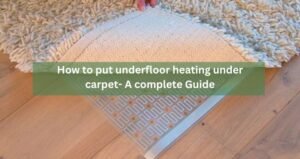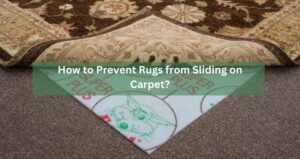If you have asthma, eczema, or allergies to substances like dust mites, pollen, or pets, it is important for you to create a hypoallergenic environment in your home to prevent triggering any negative reactions.
Carpets tend to trap allergens such as dust, dirt, chemicals, pollen, and pet dander. Therefore, if any of these substances are likely to affect your health, it is crucial to minimize the associated risks.
With so many options available, it can be overwhelming to determine which carpet is truly the best for your needs. We will assist you in finding flooring options that can reduce the chances of experiencing allergic reactions, allowing you to unwind at home and fully enjoy life.
What Types of Carpets are Hypoallergenic?
Wool Carpet
Wool stands out as an excellent choice of carpet for individuals dealing with allergies, asthma, or eczema. This remarkable natural fiber possesses inherent hypoallergenic properties, making it a top contender.
Not only does wool absorb airborne irritants such as cooking fumes, deodorants, cleaning chemicals, and smoke, but it also enhances the overall air quality within your home.
Furthermore, wool rugs exhibit resistance against bacteria, mold, and mildew, ensuring a healthier environment. Thanks to the unique coil-like shape of wool fibers, moisture is effectively minimized, making it challenging for pesky dust mites to survive in this cozy haven.
Sisal Carpets
For an exotic touch, sisal carpets are excellent alternatives. Made from natural plant fibers, these carpets are highly sustainable and possess anti-static properties, which can reduce the buildup of allergens. They also provide a unique texture that adds character to any room.
Nylon Carpets
Nylon carpets are known for their durability, stain resistance, and affordability. They are an excellent choice for households with high foot traffic or active pets.
Look for nylon carpets with low VOC (Volatile Organic Compound) emissions, as these chemicals can aggravate allergies.
Polyester Carpets
Polyester, similar to nylon, is a synthetic material that offers a fantastic choice for individuals with allergies. While it may be less costly than nylon, it does have a trade-off in terms of durability.
Nevertheless, it’s worth mentioning that both polyester and nylon fibers are hypoallergenic, making them an ideal option for allergy sufferers.
Rooms That Tend To Accumulate the Highest Levels of Allergens

- Bedrooms: Your bedroom can be a haven for allergens, especially if you have carpeting, curtains, or upholstered furniture that can trap dust mites, pet dander, and pollen. Bedding, including pillows and mattresses, can also accumulate allergens over time.
- Living Room: The living room is another hot spot for allergens. Dust mites, pet dander, and pollen can settle on upholstered furniture, carpets, and curtains. Additionally, if you have a fireplace, smoke particles and ash can contribute to poor indoor air quality.
- Basements: Basements often have higher moisture levels, making them a breeding ground for mold and mildew. Dust mites can also thrive in carpets or upholstered furniture in basements, further contributing to indoor allergens.
It’s important to note that these rooms are not solely responsible for allergen accumulation. Allergens can spread throughout your home, so maintaining good indoor air quality and regular cleaning practices in all rooms is essential for reducing allergen exposure.
Additional Tips for a Hypoallergenic Haven

Choosing the right carpet is only the first step toward achieving a hypoallergenic haven. Here are some additional tips to create an allergy-friendly environment:
- Regularly vacuum your carpet using a vacuum cleaner equipped with a HEPA (High-Efficiency Particulate Air) filter to trap allergens effectively.
- Implement a no-shoes policy to minimize the introduction of outdoor allergens into your home.
- Keep humidity levels in check to prevent mold growth, as mold spores can trigger allergic reactions.
- Consider using area rugs instead of wall-to-wall carpets, as they are easier to clean and maintain.
Invest in a good air purifier to filter out airborne allergens, promoting cleaner air quality.
By combining the right carpet choice with these practical measures, you can transform your home into a safe haven for allergy sufferers.
Do Hypoallergenic Carpets Work?
Yes, hypoallergenic carpets can be effective in reducing allergens and creating a healthier indoor environment. While no carpet can be completely allergen-free, hypoallergenic carpets are specifically designed to minimize the presence of allergens that can trigger allergic reactions in sensitive individuals.
Hypoallergenic carpets are typically made from materials and constructed in a way that discourages the accumulation of allergens such as dust mites, pet dander, pollen, and mold spores.
These carpets often have tightly woven fibers, low-pile construction, and are resistant to moisture, which helps prevent the growth of mold and mildew.
Remember, everyone’s allergies and sensitivities are unique, so it’s advisable to test different hypoallergenic carpet options and consult with our professionals to find the best fit for your specific needs.
Embrace Allergy Relief with the Best Hypoallergenic Carpet
Choosing the best hypoallergenic carpet involves considering various factors, including material, construction, and your specific needs. Whether you opt for luxurious wool, exotic natural fibers, or practical synthetics, remember to prioritize allergy-friendly features.
Take your time, explore different options, and don’t hesitate to consult with our carpet professionals at Rugs and Carpets, who can provide personalized recommendations based on your circumstances.






